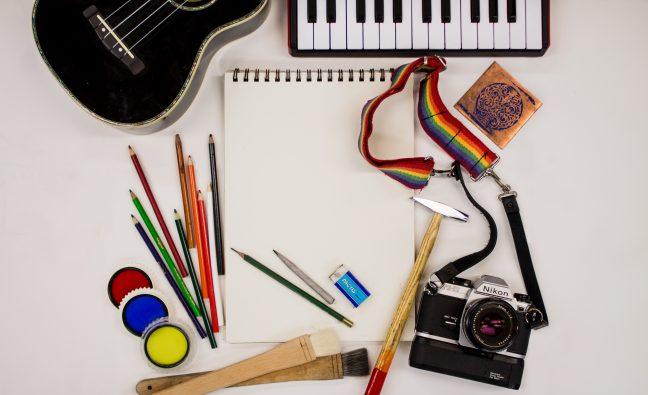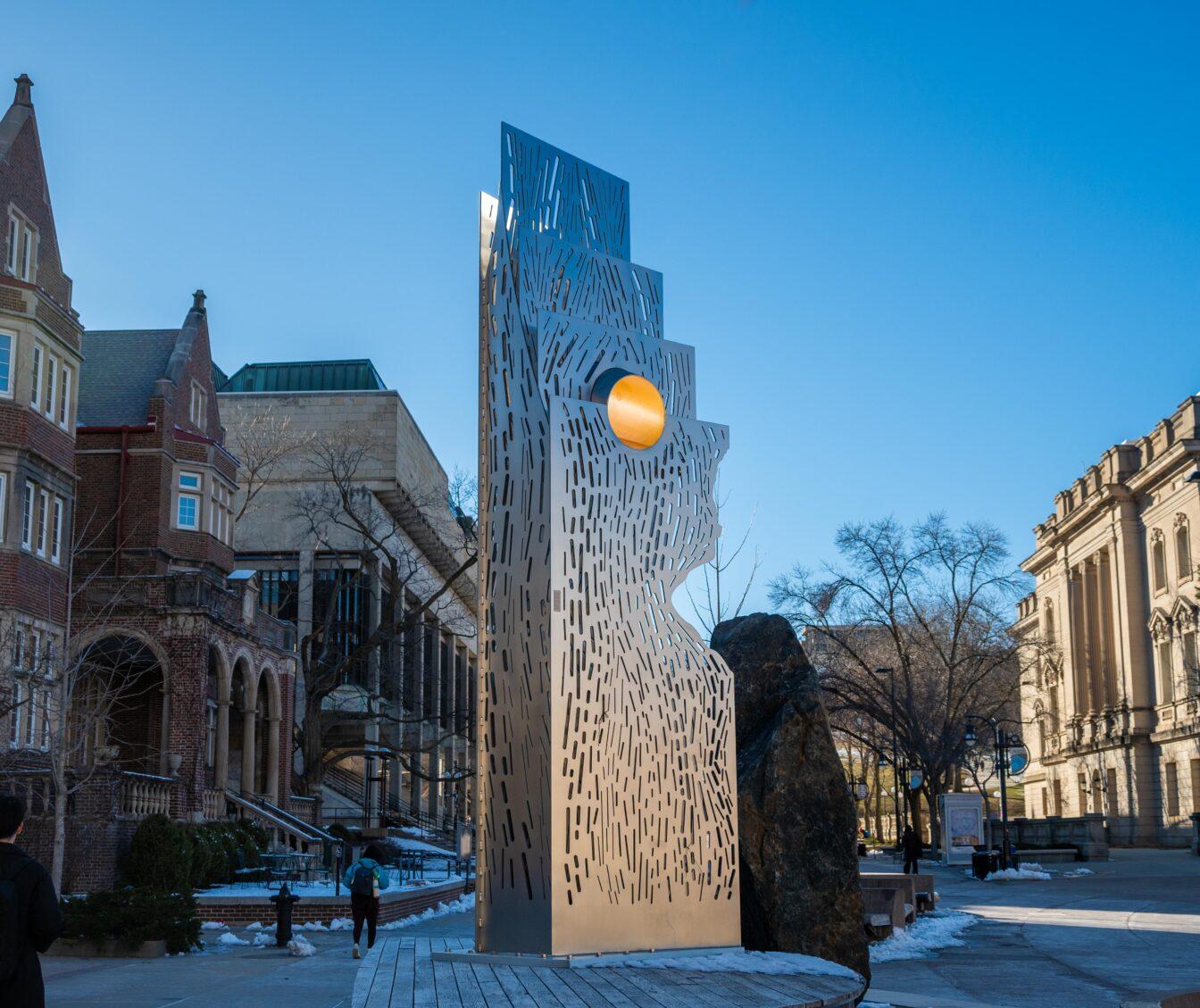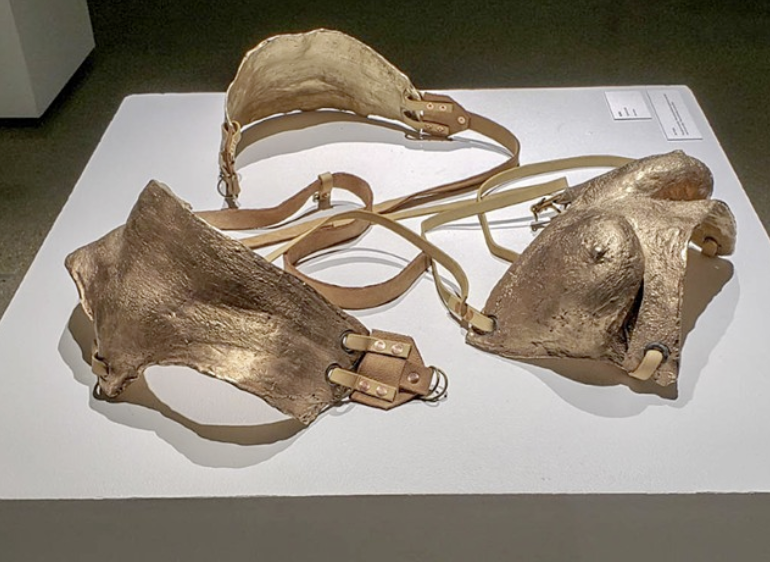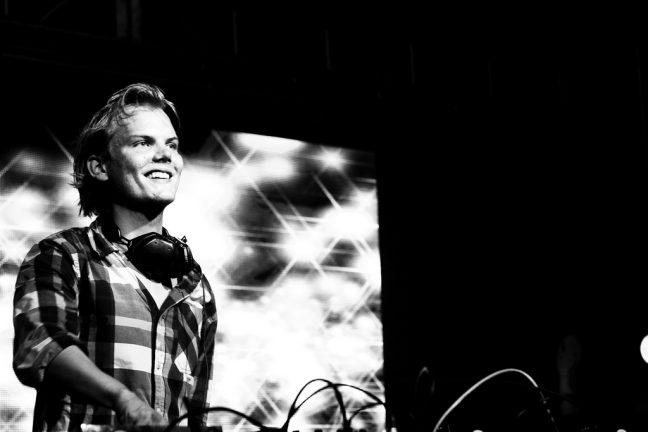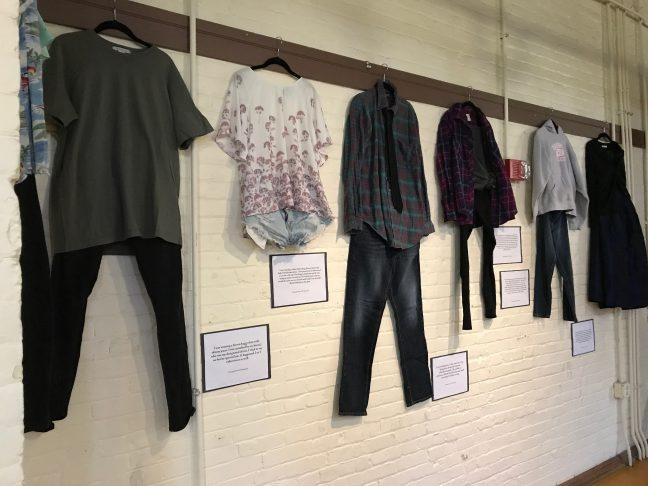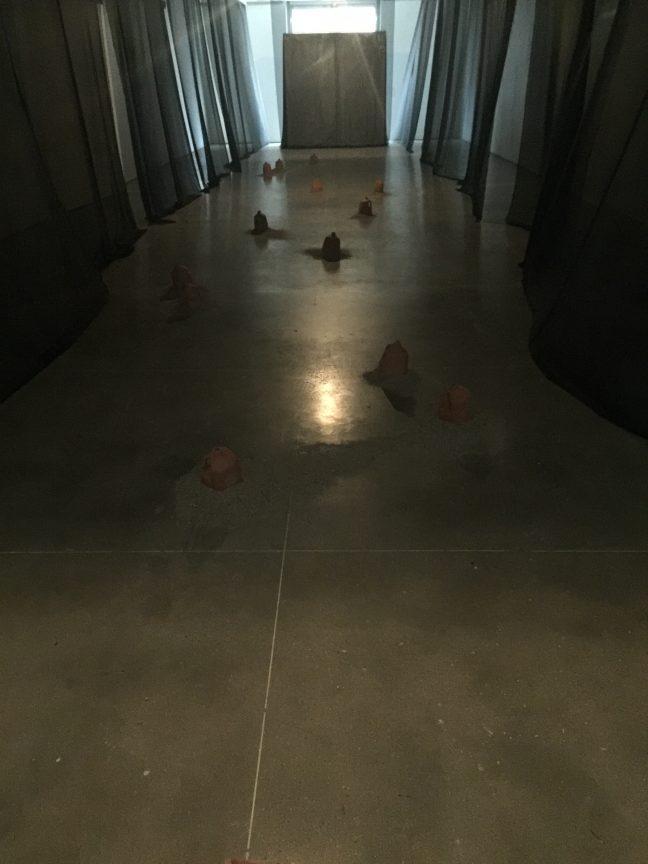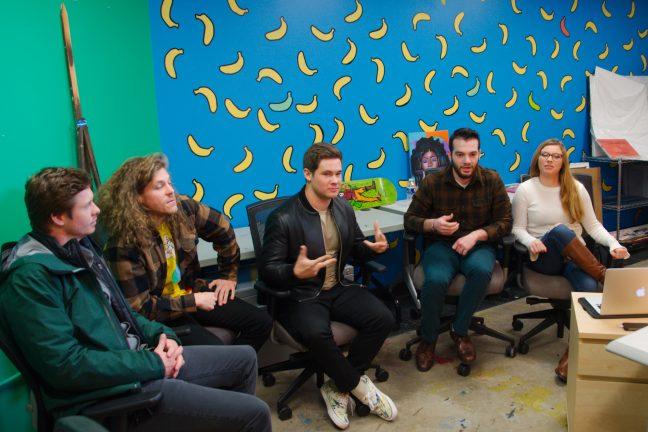Though the University of Wisconsin is known as a sports and research haven, the institution’s classrooms are teeming with art forms and artists of all kinds.
They have been doing so throughout history and continue to do so today. Artists as disparate but equally brilliant as the late architect Frank Lloyd Wright, fashion designer Virgil Abloh and TV producer/writer Jill Soloway, once roamed this campus’ many halls and took something different from their time at UW.
Wright, perhaps America’s most important architect, quickly decided school was not for him and dropped out after two semesters.
Abloh used his fashion to rebel against UW’s engineering program. In a New York Magazine profile, Soloway said it was a life-changing chance encounter near Lake Mendota that provided the impetus for award-winning shows like ‘Transparent.’
Today, artists of many disciplines, trained in classes or practicing on the side, continue to hone their crafts on campus.
The artists behind the art
Some students come to UW with a passion and art form already wedged into their brains. Others happen across theirs by chance, like taking a random course or attending some speaking event.
“It was the greatest thing ever. It was weird, but also so satisfying to be able to make something but have it reflect me, like the comedy aspect of myself.”
For UW alumnus Wade Dittburner, creative writing was not simply a hobby or even a passion. It was the only subject that made it worth attending UW in fall 2013. Growing up in the rural town of Cedar Rapids, Wisconsin, “where few make it out,” Dittburner loathed the idea of even attending college.
While his parents tried their best to convince him to give it a try, it was not until he learned from a creative writing high school teacher that he could pursue creative writing in college that he decided to hear his parents out.
Over time at UW, Dittburner was able to hone an intensely personal style of prose. He said people around him and what he read growing up influenced him.
“I grew up around a lot of people that were working class, or really they were in poverty,” Dittburner said. “They couldn’t make it out. There’s so much damage that culture does to itself. That’s what I’m trying to capture in my writing.”
Samira Mian, a UW senior double majoring in communication arts and mass communications, also thought she was going to be a writer going into college. But unable to see herself in anything she wrote, Mian quickly found it was not for her.
Instead, Mian could truly see herself in an introductory communication arts class involving a survey of different digital media forms like photoshop and filmmaking. She found she could employ these forms separately or together to create pieces of work.
“It was the greatest thing ever,” Mian said. “It was weird, but also so satisfying to be able to make something but have it reflect me, like the comedy aspect of myself.”
Through communication arts, Mian was able to continue pursuing different digital visual art forms and is now in a capstone production class to produce a short film.
Other artists come to UW and don’t study an art at all. Abby Sherman, a senior majoring in environmental studies, instead formed the nationally touring rock band Trophy Dad on the side.
Having studied various instruments in high school, Sherman had no intention to form a band. Instead it just happened through meeting the right people while living in The Studio — a floor in Sellery Hall dedicated to students interested in the arts.
Through the years, Trophy Dad would become embroiled in Madison’s music scenes, be featured in blogs like Stereogum and receive an invitation to perform at this year’s SXSW music festival in Austin, Texas.
Depending on the stress of school, some semesters were harder than others. But finding people Sherman could trust and rely on as friends made each Trophy Dad hiatus only temporary.
One of their most noteworthy tracks, “Louis Sachar,” came out of a demo that fellow member Jordan Zamansky had written, but Sherman quickly took over and inserted her own experiences and frustrations.
“That’s the beauty of working with those humans,” Sherman said. “I used to feel weird about changing up other people’s songs but over the years it’s become fine.”
Art Classrooms and Communities
Becoming a part of a trusting circle of fellow artists and collaborators is an important step for an artist based in any location. UW is no exception.
For students who pursue art during their education, classes can often provide these spaces and networks.
“We need to get to the first stage of [the student’s] thinking. What are the components that make you who you are?”
Audrey Hansa, a senior studying fine arts, finally felt the wheels come off after she came to UW. Much of the teaching in her high school art classes was foundational, whereas UW’s approach has been more like “anything goes,” she said.
This laissez-faire approach has allowed Hansa to develop a visually-striking style that draws on her childhood influences of cartoons as well as incorporates feminist and queer themes. Hansa has found spaces in her classes where she can feel comfortable enough to express herself and learn about the work and people surrounding her.
“When you work with other people, just having that community is really important,” Hansa said. “You learn about other artists, and it’s kind of like a game of ping-pong where you’re bouncing off of one another.”
Mian also said her communication arts classes have introduced her to peers who can relate to her fears of pursuing a tenuous career in digital media, as well as help her work through them.
Faisal Abdu’Allah, a UW assistant professor in the printmaking department, makes this one of the primary focuses of his teaching methods, regardless of the student’s age or experience.
Abdu’Allah tries to form safe spaces in his classrooms where students are encouraged to bring ideas to the table, make connections but also avoid being bashful. He ensures students are mindful of themselves and their individuality at least as much as they are of the task at hand.
“We need to get to the first stage of [the student’s] thinking,” Abdu’Allah said. “What are the things that inform you as a human being? What are the components of the things you are reading? What are you responding to? What are the things in the environment that you react to, i.e. your taste, your touch, your hearing? What are the components that make you who you are?”
This approach, which focuses on the “the centrality of the practitioner,” is common among Abdu’Allah’s peers in the art school.
Daniel Grabois, a horn professor in the music school, related a similar method. He said he tends to let the style of the student dictate the form of the piece rather than vice versa, and also tries to work fluidly with whatever strengths or weaknesses a student has. Creative writing professor Amy Barry-Quan said she tends to point students in directions they may not consider going rather than cut down their work.
But not every art class is guaranteed to provide this to every student.
Jonny Chang, a senior and First Wave scholar studying film production, said one of the film studies’ classes he took seemed to segregate black films from the rest of the course listings. Similarly, a scene where Asian women were fetishized went unaddressed in discussion.
Chang also said his experience being one of few people of color in a film class is difficult, especially given how intense and cooperative those classes tend to be.
Finding community outside of the classroom
The communities these classes can provide are also not exclusive to classrooms.
The First Wave program, an urban arts scholarship, has been a community for artists and alumni like poet Danez Smith and rapper crashPREZ through the years. Currently, the program has given Chang and his cohort-member Obasi Davis, a senior studying fashion design, a group of people with whom each has been able to make leaps in their respective careers as hip-hop artists.
UW alum and First Wave scholar Christian Robinson added the program also gave him the ability to showcase his talents at places like the Apollo Theatre in New York.
“I wouldn’t give First Wave all the credit,” Davis said. “But they definitely put the right people in the right room.”
Kristen Johnson-Salazar, a Junior communication arts major, also found like-minded filmmakers and buffs with Wisconsin Union Directorate Film.
In addition to finding others interested in boosting women and POC-made films, Johnson-Salazar found opportunities to contribute her skills and motivations to projects like “Hyphenated,” a photo exhibit that showcased UW students of mixed ethnicities.
Moreover, students can also find these pockets outside of UW. Meag Sergeant, a senior studying horticulture, said she was able to find photography circles and galleries to showcase her paintings primarily through word of mouth.
Alum Emili Earhart also said she was able to find pockets of collaboration outside of the music school in the greater Madison area. The people she met in Madison’s DIY scene provided a place for her to experiment with synths and different genres to complement her classical training in the music school.
“They can be hidden, but the bigger Madison area and its resources are something I think students should take more advantage of,” Earhart said.
Artistic burdens at UW
While Madison and UW offer can offer many resources, the campus can also be inhibiting for artists.
“I’m really thankful for what we got to build in Madison, but things just move ten times faster out here,”
For Jeung Bok Holmquist, a senior studying communication arts, living in Madison their whole life and now near UW’s campus has meant long stretches of isolation.
Being non-white and non-rich, they said, made them feel the need to compete with classmates instead of collaborating in high school which is something they brought to college and then had to unlearn.
Holmquist said getting the right materials and equipment can be pricey or inconvenient. When they studied abroad in Canberra, Australia, film equipment could be checked out anytime after paying a flat rate. But UW has more hurdles, like having to be enrolled in a production class.
Further, Hansa said the STEM-heavy nature of UW can also be further isolating.
Robinson also said the lack of a real music industry is what inspired him to move to Chicago one year after he graduated.
“I’m really thankful for what we got to build in Madison, but things just move ten times faster out here,” Robinson said.
Cultural and demographic differences between his native Bay Area and Madison make the latter unattractive to Davis. Though the differences have been negative, Davis said they have forced him to turn to his art and improve it.
Art enters the political
While some students use art for personal reasons, other also seek to break down political barriers.
UW junior Eneale Pickett has created fashion pieces, videos and banners that directly confront systems of oppression. Pickett has mainly used fashion to express himself because he believes it is one of the most important depictions of one’s aesthetic.
“I want people to speak truth to power without even having to open their mouth,” Pickett said. “Even if they don’t say anything, there is still a strength present in that shirt that takes it to a whole other level.
Hate and bias incidents also led to the #TheRealUW movement in spring 2016.
Students like UW senior Cortez de la Cruz decided to form an online visual, artistic campaign that eventually went viral with the messages it disseminated. The students also had a one-day exhibition at the Chazen Museum with original art pieces.
De la Cruz, an emcee, poet and First Wave Scholar, said the organizers of the event chose their artistic strategy because they felt it was a last resort after conventional methods like emailing fell short.
“Nothing else was working,” de la Cruz said. “Emails didn’t work, walking up to the actual staff didn’t work because people were always out of the office. Art was the only way that we could get the message to people to judge from the comfortability of their own home.”
Intersectionality and interdisciplinary art
Many artists at UW are also reconciling how to make art that serves both themselves and the right purpose in the 21st century.
It’s something that has put Chang in artistic droughts at times but has also driven him forward at others. In his song, “Give,” Chang said he was able to synthesize his personal struggles of feeling underrepresented in the film industry with a message about solidarity.
“Everything I had gone through in Madison just sort of came together on that track, as well as on the last track of the Where the Home is EP as well,” Chang said.
Hansa said she has also been thinking about creating similar art recently. It has led her to be more thoughtful about painting non-binary characters and made her think how her own identity should impact her art.
It also led Hansa to think about creating more interdisciplinary art — works of art that blend different disciplines or fields together.
“It’s not just about appealing to everybody,” Hansa said. “It’s about finding different ways to express something. And sometimes one way picks up the slack where another can’t express something, or together it creates something even more powerful.”
Many UW students create and collaborate interdisciplinarily through designated spaces like the new electroacoustic studio Grabois initiated or The Studio dorm floor that Abdu’Allah now facilitates.
Mian also said her production design classes have often brought together folks with talents ranging across a wide breadth of fields, such as Chang, Holmquist and Johnson-Salazar.
But for more interdisciplinary experimentation to occur, there needs to be a more central art administration on campus rather than the current system where many different forms of art are divided into various academic departments, Professor Joeseph Koykkar, a music director and sound technician in the Dance Department, said.
The division of art programs, he said, can separate potential collaborators from one another. Koykkar attempted to fix this through his Interarts and Technology program in 1995 but it ultimately folded due to a lack of support.
Though students like Earhart somewhat disagree. While she wishes there were more options to experiment in the classroom, the organic occurrences when she was able to do so made the experience all the more special.
Abdu’Allah said he is for increasing the collaboration between art students and students in other fields or disciplines. For him, the experience makes the end product even better.
“I like this practice of going into this other place, of crossing this threshold,” Abdu’Allah said. “It means I bring something to that space and when that person comes into my threshold they’re doing it as well. For me, that journey and crossing those thresholds it imbues the object with something else. It makes it that much more magical.”








